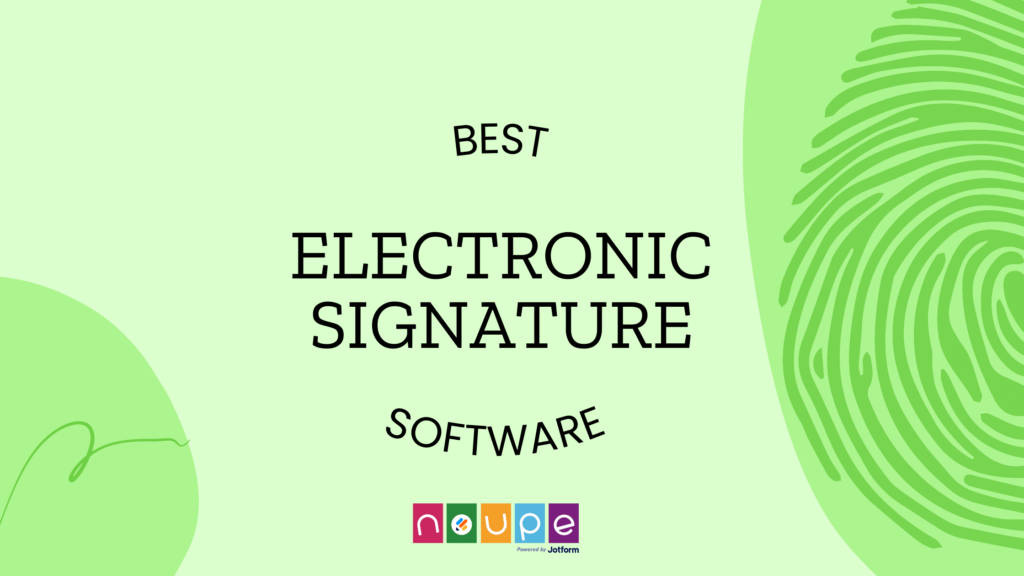Best Electronic Signature Software of 2024
Thanks to advanced e-signature tools, there has been a shift away from traditional paper-based signatures. These tools and platforms streamline the signature collection process, from contracts to agreements, ensuring swift and secure transactions with digital solutions. Selecting the most suitable e-signature solution is important for ensuring smooth document signing experiences in business settings, guaranteeing efficiency and security throughout the procedure.
Excited to see what’s out there in the e-signature market? Check out our breakdown of 7 e-signature solutions, where we’ve considered factors like security, user-friendliness, integrations, and pricing flexibility.
Jotform Sign
Jotform Sign simplifies the creation of automated approval processes for e-signature documents, making secure document sharing and signing a breeze across all devices. With its intuitive drag-and-drop builder and extensive library of customizable templates, users can effortlessly create legally binding documents, including contracts and approvals. Jotform Sign offers real-time report generation, secure online document embedding, and seamless integration with Jotform Tables for efficient data management and insights. As an all-in-one electronic signature and document solution, Jotform Sign streamlines document processes and data management, featuring automated approval flows and versatile integrations with various external platforms.
With hundreds of templates and an intuitive design interface, users can easily customize documents without any coding knowledge, making it ideal for small businesses seeking efficiency. Documents are easily shared via a link or QR code and accessible from any smart device, ensuring full legal compliance with CCPA, GDPR, and PCI standards, with optional HIPAA compliance features available.
Features
- Drag-and-drop builder
- Easy sharing options
- Strong security and compliance capabilities
- Embeddable into websites
- Document delegation
- Live reports
- Automated approval flows
- A wide range of integrations
- Easy data analysis
Pricing
Jotform’s pricing model is based on the level of form usage, granting access to all features across all plans except for those related to HIPAA compliance. Moreover, Jotform provides a 20% discount for annual subscriptions, which encompass four distinct plans.
- Starter Plan: No charge fee with 10 sign limit
- Bronze Plan: Monthly payment of $34 on a yearly subscription with 100 sign limit
- Silver Plan: Monthly payment of $39 on a yearly subscription with 250 sign limit
- Gold Plan: Monthly payment of $99 on a yearly subscription with 1000 sign limit
Jotform also offers an Enterprise Plan with exclusive features and terms. It’s worth noting that Jotform provides a 50% discount for educational institutions and non-profit organizations.
Signaturely
Signaturely provides a cloud-based e-signature platform to streamline document approvals for businesses. Key features include alerts, bulk sending, team oversight, version management, customizable branding, audit trail, and data import functionalities.
Users can either upload files or use premade templates to prepare documents, incorporating necessary fields to guide signers through the process. Signers conveniently receive documents via email and can access them remotely from any device. Managers can set up automatic reminders to keep track of documents that are waiting to be signed, already signed, or not signed yet. These documents can be kept together in one central place.
Signaturely records digital imprints of signees’ interactions, including IP addresses, locations, names, and email addresses. Additionally, managers can monitor document views, signings, and transmissions. Integration with various third-party applications such as Dropbox, OneDrive, Google Drive, and Box is seamlessly offered.
Features
- Legally binding e-signatures
- Multiple document recipients
- Custom signing order
- Automated reminders
- Guided signing
- Bulk contact import
Pricing
- Subscription options are available on both an annual and monthly basis.
- Personal Plan: Yearly $240 payment with 5 per month signature requests.
- Business Plan: Yearly $480 payment with unlimited signature requests.
Dropbox Sign
Dropbox Sign makes it easy to sign documents with its easy-to-use design and simple features. You can send, track, and get notifications for signed documents easily. It works well with Dropbox, so you can manage your files easily.
It offers features to help manage documents easily. You don’t need to print or scan documents and can send documents directly from your Dropbox account. You can also add more than one person to sign a document easily. It keeps your documents safe with encryption and lets you set when people can access them.
Users can also work together easily with Dropbox Sign. Users can share and manage signed documents with colleagues, clients, or partners easily. You get updates in real-time about your documents, so you know when they are viewed, signed, or completed.
Features
- Reusable templates
- Mobile-friendly forms
- No-code integrations
- Customizable experiences
Pricing
- Basic: Free trial plan
- Plus: Monthly payment of $9.99 on a yearly subscription with 1 user limit
- Essentials: Monthly payment of $18 on a yearly subscription with 1 user limit and unlimited sign requests
- Business: Monthly payment of $20 on a yearly subscription with 3+ user limit recommended for teams
- Business Plus: Monthly payment of $26 on a yearly subscription with 3+ user limit recommended for companies
PandaDoc
PandaDoc helps you get agreements faster with fewer delays. Its easy-to-use approval workflows reduce mistakes, so you can send agreements out quickly. With a clear signing order, you can get the signatures you need in no time.
Managing documents is also easy with PandaDoc. Instead of using multiple tools for electronic signatures, you can consolidate your workflow into one platform and upload, send, and eSign PDFs, DocX, and other files quickly. You can sign documents knowing they’re secure as PandaDoc provides a certificate of authenticity for each completed document. It offers recipient verification via passcode and SMS for added protection. Plus, your data is protected as PandaDoc is compliant with ESIGN, UETA, HIPAA, and SOC 2 Type II standards.
Features
- Template options
- Multiple languages
- Real-time notifications
- Custom branding
Pricing
- Free: No fee charge with 14-day trial period
Essentials: Monthly payment of $19 on yearly subscription with unlimited document uploads and e-signatures - Business: Monthly payment of $49 on yearly subscription with unlimited document uploads and e-signatures
- Enterprise: Custom pricing with unlimited document uploads, single sign-on (SSO) and team workspaces
- PandaDoc also offers a per-document pricing package with unlimited seats and you pay only for the documents you create.
Zoho Sign
Zoho Sign is another valuable tool for businesses seeking efficient document signing solutions. Its user-friendly interface simplifies document uploads, signer additions, and signature requests, making the process easy for users and clients alike. With strong security measures like encryption and compliance with industry standards, such as SOC 2 Type II and GDPR, Zoho Sign ensures data integrity and confidentiality. Integrations with popular business applications like Zoho Suite and Microsoft Office streamline workflows, while multi-party signing capabilities enable smooth handling of complex document processes.
Zoho Sign’s mobile app allows users to sign documents anywhere as well.
Features
- Mobile accessibility
- Easy-to-use interface
- Handles complex processes easily
- Multi-party signing capabilities
- Advanced security measures
Pricing
- Free: No fee charged for a single user and a 5 envelopes per month limit
- Standard: Monthly payment of €10 on a yearly subscription with 25 envelopes per user per month
- Professional: Monthly payment of €16 on a yearly subscription with unlimited envelopes per user per month
- Enterprise: Monthly payment of €22 on a yearly subscription with the features of professional plus special features like payment collection and bulk send & bulk sign.
Adobe Sign
Acrobat Sign simplifies document signing with essential e-signature tools. Its user-friendly features like mobile accessibility streamline document management. Real-time notifications and mobile app support allow for efficient handling of signings wherever you are. Its integration with Microsoft 365 enhances workflow efficiency, allowing seamless document processing from familiar applications.
Additionally, Acrobat Sign’s automatic record-keeping guarantees secure storage of signed documents and audit trails. With features like agreement templates, mega sign for bulk sending, and branded experiences, Acrobat Sign offers a comprehensive solution for businesses seeking efficient and secure document signing processes.
Acrobat Sign prioritizes security and compliance with global regulations. Its authentication methods verify signer identities, ensuring secure transactions. Customizable workflow templates reduce errors and streamline the signing process. Moreover, Acrobat Sign’s extensive APIs enable easy integration with various applications, expanding its functionality. By simplifying compliance and offering secure e-signatures, Acrobat Sign empowers businesses to boost document signing processes with confidence.
Features
- Tracking and management
- Microsoft Office integration
- Access and control reminders
- Audit trail
- Advanced security measures
Pricing
Adobe Acrobat Sign has 2 different pricing models for teams and individuals.
For Individuals
- Adobe Standard: $12.99 monthly payment on an annual subscription
- Acrobat Pro: $19.99 monthly payment on an annual subscription
For Teams
- Adobe Standard: $14.99 monthly payment on an annual subscription
- Acrobat Pro: $23.99 monthly payment on an annual subscription
DocuSign
DocuSign efficiently oversees all signing transaction phases, from document preparation to signing and organization, delivering efficient results. Businesses benefit from time and cost savings with streamlined procedures. Emphasizing security, all transactions remain legally valid and traceable, supported by thorough audit trails.
The Individual Edition simplifies document handling for personal use, while the Business Edition automates workflows for SMBs, ensuring secure transactions from any location. Enterprises find value in DocuSign for the Enterprise, meeting rigorous IT standards while enhancing customer interactions.
The DocuSign mobile app facilitates document operations from any device, offering a comprehensive set of features including document assembly, data security, and signer authentication. Professional Services ensure a smooth transition to digital transactions, guaranteeing seamless implementation across departments or enterprise levels.
Features:
- Multi-party signing
- Document storage
- Mobile signature capture
- Authentication
- Customizable templates
Pricing
- Free: No charge trial
- Personal: Monthly payment of $10 on a yearly subscription with 5 envelopes per month
- Standard: Monthly payment of $25 on yearly subscription with additional features to a personal plan
- Business Pro: Monthly payment of $40 on a yearly subscription with additional features like bulk send, payments, and signer attachments
- Enhanced Solutions: Customize a pricing plan that scales to your special needs
Conclusion
E-signature tools offer improved efficiency and security for businesses. Notably, solutions like Jotform Sign have emerged with user-friendly interfaces and seamless integration capabilities. Whether for individuals or large enterprises, e-signature solutions are a vital piece of technology to streamline document management and ensure compliance. With features such as mobile access, multiple-party signing, and strong security, e-signature tools guarantee smooth transactions and contribute to business success today.
The post Best Electronic Signature Software of 2024 appeared first on noupe.































